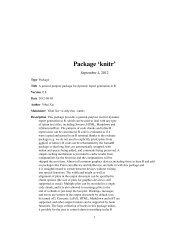Package 'openair'
Package 'openair'
Package 'openair'
Create successful ePaper yourself
Turn your PDF publications into a flip-book with our unique Google optimized e-Paper software.
136 trajLevelsmoothstatisticpercentilemapDetailslon.inclat.incmin.binand labelled accordingly. If type is an existing character or factor variable, thenthose categories/levels will be used directly. This offers great flexibility for understandingthe variation of different variables and how they depend on oneanother.type can be up length two e.g. type = c("season", "weekday") will producea 2x2 plot split by season and day of the week. Note, when two types areprovided the first forms the columns and the second the rows.Should the trajectory surface be smoothed?For trajLevel. By default the function will plot the mean concentration ofa pollutant. If statistic = "frequency", a plot will be shown for griddedtrajectory frequencies. This is useful to understand where air masses tend toorginate.It is also possible to set statistic = "difference". In this case trajectorieswhere the associated concentration is greater than percentile are comparedwith the the full set of trajectories to understand the differences in freqeuncies ofthe origin of air masses. The comparsion is made by comparing the percentagechange in gridded frequencies. For example, such a plot could show that the top10% of concentrations of PM10 tend to orginate from air-mass origins to theeast.For trajLevel. The percentile concentration of pollutant against which theall trajectories are compared.Should a base map be drawn? If TRUE the world base map from the maps packageis used.The longitude-interval to be used for binning data for trajLevel.The latitude-interval to be used for binning data when trajLevel.For trajLevel the minimum number of unique trajectories in a grid cell. Countsbelow min.bin are set as missing. For statistic = "frequency" or statistic = "frequency"... other arguments are passed to cutData and scatterPlot. This provides accessto arguments used in both these functions and functions that they in turnpass arguments on to. For example, plotTraj passes the argument cex on toscatterPlot which in turn passes it on to the lattice function xyplot whereit is applied to set the plot symbol size.groupFor trajPlot it is sometimes useful to group and colour trajectories accordingto a grouping variable. See example below.Several types of trajectory plot are available. trajPlot by default will plot each lat/lon locationshowing the origin of each trajectory, if no pollutant is supplied.If a pollutant is given, by merging the trajectory data with concentration data (see example below)the trajectories are colour-coded by the concentration of pollutant. With a long time series therecan be lots of overplotting making it difficult to gauge the overall concentration pattern. In thesecases setting alpha to a low value e.g. 0.1 can help.For the investigation of a few days it can be useful to use plot.type = "l", which shows theback trajectories as continuous lines rather than individual points. Note that points help to show theduration an air mass spend in a particular location, whereas lines do not.
















